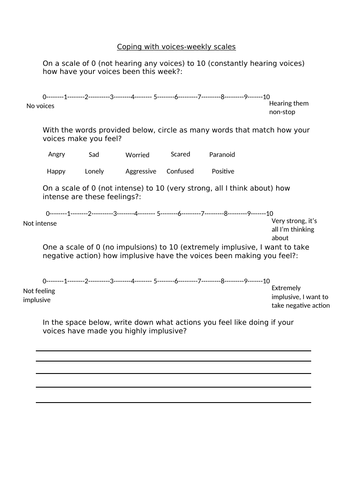





These activities will help individuals cope with negative or unwanted voices that they experience and help with ways to reduce and control the voices.
The first resource is weekly scales that can be given to the individual on the start of their sessions. The scales will ask the individual to rate how their voices have been this week, to circle what words they feel match how their voices make them feel, they will be asked to rate how intense their feelings are due to the voices, they will be asked to rate how impulsive the voices make them feel and write down the actions they think they would do if they felt impulsive due to the voices. By doing these weekly scales it can help the individual see if they are progressing throughout the weeks and see when they have bad weeks and figure out why it is their voices have been particularly bad that week, for example, feeling stressed.
The second resource is all about understanding what the voices say and look like. This activity will help the individual learn how to cope with the voices in their head by understanding what the voices are saying and how our body and mind reacts to them. The activity will ask individuals to use the cut out of a body and draw how their body reacts to what their voices say to them. For example, if their hands shake or if their heart races. They will then be asked to use the cut-outs of the heads to draw what their voices would look like as a face, for example, would they be a sad or angry face? Finally, with the cut-outs of word bubbles they will be asked to write statements that their voices might say to them, for example, telling them to do something they don’t want to.
The third resource is allows the individuals to write a letter to help them learn how to tackle their voices and help them explore why they don’t like what their voices and how the voices make them feel.
The forth resource is exploring their impulsivity and learning how to control their implusive actions. The resource gives the example of our impulsivity and angry with put voices being like an erupting volcano, the individuals are then asked to use the cut-outs of an erupting volcano to write down the stages of how the voices make them get more and more angry and how they develop implusive actions. Now that they have the stages of how they get implusive, the individuals will be asked to use the cut-outs of the rain drops to then give examples of how they can tackle these impulsive actions that the voices cause.
The final resource explores creating distractions, the individuals will first be asked to write down examples of what they think might be good distraction techniques to help reduce the impact of their voices. With these personalized examples they will then be asked to make their own distraction kit where they can place in a box all the things that help reduce their voices. For example, a play list of the songs they like, puzzle books etc.
Something went wrong, please try again later.
This resource hasn't been reviewed yet
To ensure quality for our reviews, only customers who have purchased this resource can review it
Report this resourceto let us know if it violates our terms and conditions.
Our customer service team will review your report and will be in touch.